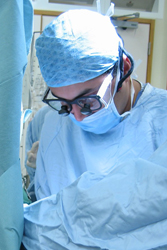Vascular Studies Unit |
B56
|
How can an aortic aneurysm be treated?
How can an aortic aneurysm be treated?

All surgical procedures carry some risk, and with small aneurysms the risk of the procedure to repair the aneurysm may be greater than the risk from the aneurysm itself.
Small aneurysms can be followed up with regular scans (usually ultrasound) to keep a close eye on their size.
Once an aortic aneurysm reaches a certain size, the risk of it rupturing becomes more likely and so the relative risk of repairing the aneurysm reduces.
It is much safer to repair an aneurysm before it ruptures- this is called an ‘elective’ repair. Elective repair can be carried out either by open abdominal surgery, which is the traditional method, or by endovascular aneurysm repair (EVAR) using a stent-graft.
Before having an aneurysm repair, you will have a CT scan to provide a very detailed picture of your aneurysm. Depending on a number of factors seen on the CT scan you may be given the option of EVAR rather than open surgical repair.
Some patients (about 50%-60%of cases) are not suitable for EVAR because the shape of their aneurysm is unfavourable and the likelihood of complications from EVAR is too great. In this situation, we would usually advise open surgical repair as the safest treatment.
In those patients with aneurysms that are suitable for EVAR, the benefits and risks of both EVAR and open surgical repair can be discussed and a decision made as to the most appropriate treatment.
Related Links
Endovascular Aneurysm Repair (EVAR) Patient Information
Abdominal Aortic Aneurysm (AAA)
Next Section: Open Aneurysm Surgery


